Japan
Wood Products Prices
Dollar Exchange Rates of 25th
Jun
2021
Japan Yen 110.89
Reports From Japan
Signs of another COVID-19
rebound in Tokyo
As the number of corona virus cases continued to decline
nationwide and the fourth wave of infections appeared to
have peaked, the Japanese government lifted the state of
emergency in all prefectures except Okinawa. However,
strict measures remain in place in seven of the nine
prefectures where the state of emergency was in place.
Behind this move was evidence that the burden on the
health care system is beginning to lessen. However, signs
of another COVID-19 rebound in Tokyo were emerging
towards month end. During a meeting at the Tokyo
Metropolitan Government infectious disease experts
warned that new cases in the capital have been increasing
steadily for two weeks, foot traffic has grown since virus
measures were loosened and highly contagious variants
are spreading rapidly.
Inflation is back for the first time in 14 months
According to the Bank of Japan (BoJ) inflation has turned
positive for the first time in 14 months driven by rising
commodity costs, especially fuel, and this has resulted in
consumer prices.
This is welcome news for the Bank but to have any
meaningful impact the rise needs to be higher and
sustained because it is far below that in most other
developed economies where interest rate hikes are being
considered. The BoJ forecasts inflation staying below its
2% target for the foreseeable future as a revival of
consumer spending is a distant dream.
In its latest assessment of the economy the BoJ has warned
that consumption was "stagnating". Despite this the Bank
kept its assessment that the economy was showing signs of
recovery thanks to strong exports. The Governor of the
BoJ said if the vaccine rollout can be speeded up there's a
chance that consumption may recover faster than
expected.
See:
https://www.japantimes.co.jp/news/2021/06/18/business/japaninflation-june/
In related news the BoJ has announced a plan to boost
funding to address climate change following decisions by
central banks in several OECD countries to address the
risks from climate change on their economies.
The BoJ said it will launch a climate change scheme this
year which will provide funds to financial institutions that
increase loans and investment for activities aimed at
combating climate change.
While details are yet to be decided the BoJ said the
scheme will be similar to its programme that offers cheap
loans to financial institutions that boost lending in sectors
considered to be growth industries.
See:
https://www.reuters.com/world/asia-pacific/boj-mayextend-pandemic-relief-scheme-keep-stimulus-intact-2021-06-17/
Machinery orders hint at private sector optimism
Japan's core private-sector machinery orders rose slightly
in April from the previous month. The orders, which
exclude those for ships and from electricity utilities due to
their volatility, totalled 802.9 billion yen ($7.3 billion),
according to the Cabinet Office. Machinery orders, seen as
a leading indicator of corporate capital spending, rose for
the second straight month.
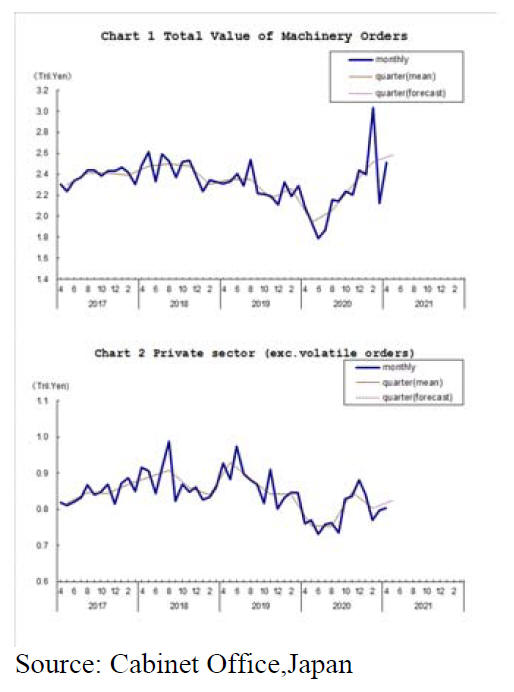
The faster the vaccine roll-out the earlier
consumption
will rise
Assets held by Japanese families have been rising steadily
compared to last year and stood at a record yen1,946
trillion yen at the end of March. Households have
naturally cut back on unnecessary spending as they are
unsure what the future holds in store.The negative impact
of the pandemic on spending will only be pushed back
when the vaccine roll-out is speeded up.
Economists say people will, as in other countries,
open
wallets once the pandemic ends. While pent-up demand
may eventually support private consumption, which makes
up more than half of the economy, exporters face major
challenges from a global chip shortage and shipping
problems.

Combination of issue drives yen lower
The yen dollar exchange rate in recent days has followed
the general US dollar recovery seen with other currencies
because of the US Federal Reserve stance on inflation
along with a dip in Japan¡¯s PMI data. Sentiment was
weakened further by the outlook for the Japanese economy
revealed in the latest BoJ meeting minutes.
Towards month end the yen was at 110.9 to the US dollar,
a level not seen in two months.
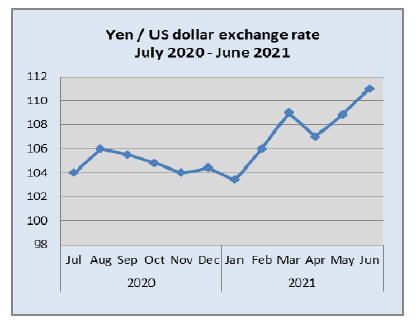
Rethinking housing priorities in Japan in
the wake of
COVID-19
With remote work likely to remain beyond the pandemic
house builders are assessing how they can adjust to better
meet the needs of those working from home.
In Japan floor space is a critical issue because of high land
costs especially in the cities so homes tend to be small and
cramped.
The pandemic, however, has scrambled the real estate
market as quarantines, states of emergencies and selfimposed
isolation prompt millions to work from home and
rethink their housing priorities.
The job placement company Biz Hits conducted a survey
and this is reported in the Japan Times. Most respondents
(85%) said they used the living room or bedroom as their
workspace which, they pointed out, was unsatisfactory.
Most said they wanted a dedicated home office space.
According to the Japan Productivity Center, while the
number of people working from home has started to fall it
still hovers around 25% of the workforce and it is the
needs of these people home builders will seeking to satisfy
through innovative use of space.
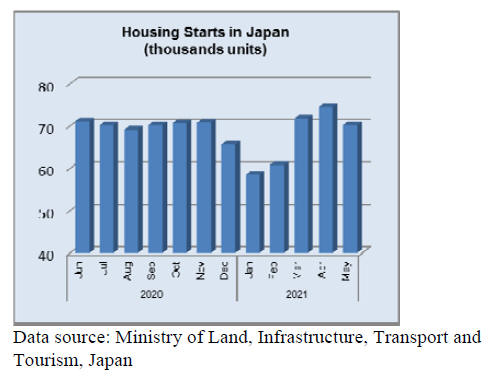
Import update
Furniture imports
After an uptick in the value of wooden office and kitchen
furniture at the beginning of the year as the second quarter
opened there were signs of a downward correction. In
contrast, wooden bedroom furniture imports to Japan fell
in the first quarter but picked up in April.
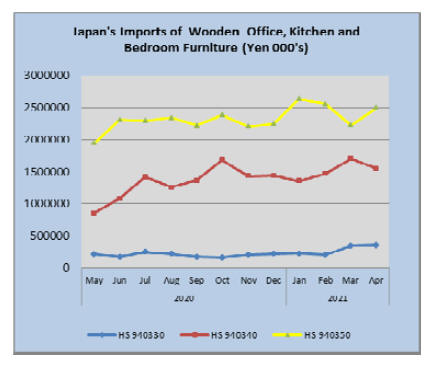
Office furniture imports (HS 940330)
Year on year the value of Japan¡¯s imports of wooden
office furniture (HS940330) in April doubled. This is more
a reflection of the low level of imports in April 2020 rather
than increased demand.
Compared to the value of imports in March there was
virtually no change in the value of imports in April.
Shipments of wooden office furniture (HS940330) from
the main suppliers China, Vietnam and those in SE Asia
were little changed from levels reported for March, the
exception being those from France. In March shippers in
France jumped into the top league of suppliers accounting
for around 30% of imports but in April arrivals from
France represented just 19% of the value of April arrivals.
Data from the Japanese Ministry of Finance shows China
was the main supplier of wooden office furniture in April
accounting for 66% of imports followed by France at 19%
and the US 4%.
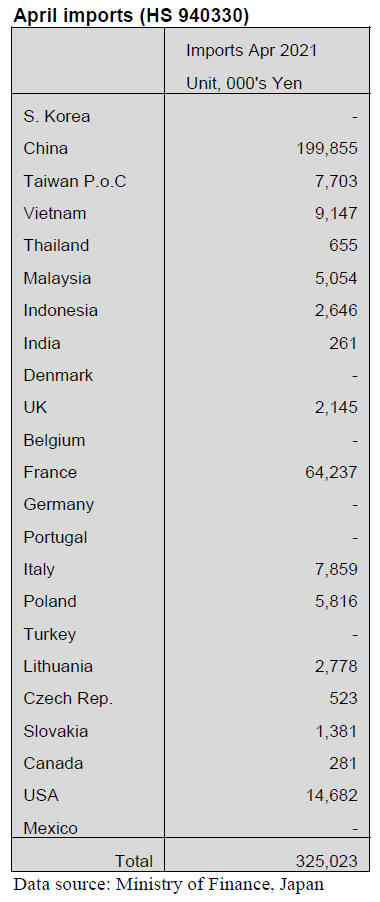
Kitchen furniture imports (HS 940340)
The steady rise in wooden kitchen furniture (HS940340)
imports came to an end in April. Compared to the value of
March imports April saw a 9% decline. Given the low
level of imports in April 2020 it is not surprising that April
2021 imports were worth over 40% more.
Shippers in the Philippines continue to dominate Japan¡¯s
wooden kitchen furniture imports accounting for around
41% of April imports but shipments from the Philippines
dropped 14% month on month.
Shipments from Vietnam were close behind those from the
Philippines accounting for 37% of April imports but this
again was a drop (7%) compare to a month earlier. The big
winners in April were exporters in China who saw exports
of wooden kitchen furniture jump by over 30%. In March
shipments of wooden kitchen furniture from Thailand
were high but in April arrivals dropped 50%.
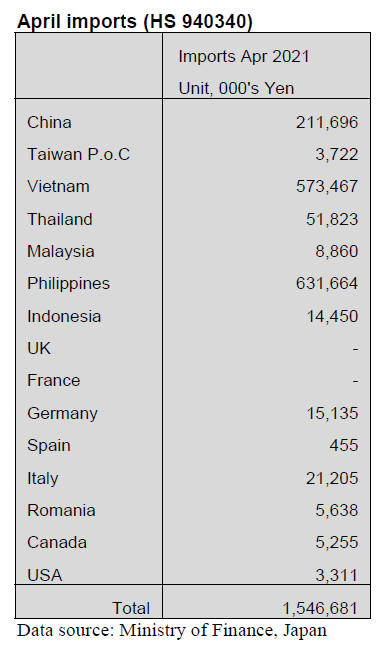
Bedroom furniture imports (HS 940350)
Year on year the value of Japan¡¯s imports of wooden
bedroom furniture rose 6% and compared to March
arrivals in April were 12% up.
The big winners in April were shippers in China who saw
a 35% increase in the value of shipments. This came at the
expense of shippers in Vietnam, Thailand and Malaysia
where shipments were well down. The value of Japan¡¯s
wooden bedroom furniture in April from Vietnam and
Thailand dropped around 10% while imports from
Malaysia were down around 30% in April.
In April shipments of wooden bedroom furniture from
China accounted for 58% of the value of Japan¡¯s total
wooden bedroom furniture imports. Shipments from
Vietnam accounted for 32%, Malaysia 4% and exporters
in Poland saw a doubling of the value of exports which
accounted for around 4% of Japan¡¯s total wooden
bedroom furniture imports.
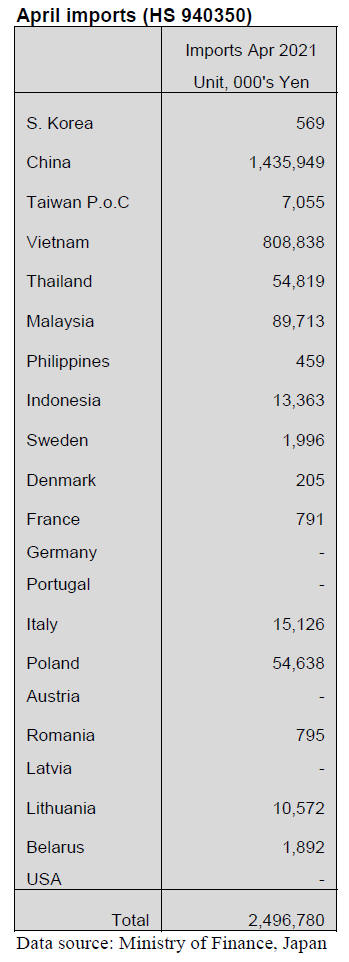
Trade news from the Japan Lumber Reports (JLR)
The Japan Lumber Reports (JLR), a subscription trade
journal published every two weeks in English, is
generously allowing the ITTO Tropical Timber Market
Report to reproduce news on the Japanese market
precisely as it appears in the JLR.
For the JLR report please see:
https://jfpj.jp/japan_lumber_reports/
Softwood plywood price hike
Softwood plywood manufacturers announced price hike
since June. New price is 1,000 yen per sheet delivered on
12 mm 3x6. The manufacturers¡¯ inventory continues low
then orders are increasing. Material log cost continues
high and adhesive prices are climbing so the
manufacturers decided to increase the prices by increasing
demand and cost push.
There was worry about demand decline when precutting
operations slow down by lack of building materials but the
orders for plywood continues active and June plywood
production is all sold out.
Inventory of structural softwood plywood by the
manufacturers at the end of April was 85,900 cbms, less
than 0.4 month then many plywood plants shutdown for
about a week during holidays in early May for
maintenance so May production dropped and the inventory
further dropped.
The dealers are trying to build up inventory in case of
supply shortage. The manufacturers ship out the products
as soon as they are made so delay of delivery started since
March.
Some wholesaler says that delivery is only 20% of what
they ordered so the business is running on hand to mouth
basis. The most concern to plywood manufacturers is
inflating production cost. Cedar log prices in the North
East are 12,000 yen per cbm delivered and in the Western
Japan are 13,000-14,000 yen.
With shortage of imported wood products, demand for
domestic cedar is getting strong and some sawmills started
using B class logs, which are normally for plywood so
further price escalation is likely all over Japan. Also
demand for larch and cypress is increasing like cedar,
which are used for face and back of plywood.
Some plywood mills increase use of North American
Douglas fir to supplement tight supplied larch and cypress
but Douglas fir supply is also tight. Adhesive prices are
also rising by worldwide demand increase for chemical
products. Present market prices of 12 mm 3x6 panel are
930-950 yen per sheet delivered so the manufacturers
increase the prices by 50-70 yen per sheet since June 1.
Russia imposes export duty on green lumber
The Russian government announced to impose export duty
on green lumber since July 1.
Green lumber means lumber with moisture content of 22%
or more. This applies to not only softwood but hardwood
lumber like oak and ash. Duty rate is 10% but minimum
prices are set like more than Euro 13 per cbm on softwood
lumber and more than Euro 15 on hardwood lumber.
There is no definite regulation to specify how to prove
moisture content.
The most affected market by this is China, which imports
large volume of Russian hardwood lumber and also some
in Europe. In Japan market, main imports are KD lumber
but some larch lumber could be affected by this regulation.
Plywood
Movement of domestic softwood plywood is very active.
It was forecast that the demand for plywood would decline
when operations of precutting plants slow down because
of shortage of imported building materials but orders of
plywood from precutting plants remains active and dealers
are trying to build up inventory in distribution channel so
the orders are filling up of plywood manufacturers¡¯
production schedule.
The manufacturers¡¯ inventory dropped more in May
because of shutting down for maintenance and shipment is
more than production now and it takes more time for
delivery. The manufacturers asked higher prices since
June and the buyers are hastily accepting the proposal to
secure the volume.
Imported South Sea hardwood plywood supply is in
critical stage. The largest supplier in Sabah, Malaysia
stopped taking any order in May because of shortage of
log supply and workers and other suppliers¡¯ offer volume
is minimal because of log supply shortage so delayed
shipment becomes now normal.
Then since June 1, Malaysia locked down for two weeks,
which further reduce log supply. Indonesia is also
suffering log supply shortage and with brisk orders for the
North America, there is no chance that the volume for
Japan would increase.
Domestic logs and lumber
Supply shortage of imported wood products is getting
severe since last March and substituting materials are
scrambling so that the prices keep soaring without no end.
In Kanto region, prices of KD cedar 105 mm square and
stud skyrocketed to about 90,000 yen, 15,000-20,000 yen
up and of 4 meter cypress sill are 100,000 yen, 25,000-
30,000 yen up. The prices change day after day.
House builders normally set the prices for several months
but now they are asking dealers to get the necessary
volume regardless of the prices.
The domestic KD lumber prices of all type such as post,
beam, stud, purlin and brace regardless of species and
sizes are now reaching level of 100,000 yen.
Sawmills increase the production so mills are scrambling
logs. Log prices, therefore, have been soaring sharply
since last April. National average of cedar post cutting
logs are 13,000-14,000 yen but in Kyushu and Northern
Kanto, they are about 17,000 yen with spot prices of
20,000 yen.
This is the highest in forty years. 4 meter sill cutting
cypress log prices are 20,000-23,000 yen but in Kyushu,
spot prices are 30,000 yen, the highest in forty years.
Stimulated by high prices, log production is active but
rainy season is coming so log production may decrease in
June and July.
Soaring New Zealand radiate pine log prices
Export prices of New Zealand radiate pine logs are
soaring. Late May and early June shipment prices steeply
increased by US$24-25 per cbm and future increase is
certain.
Sawmills cutting radiate pine logs in Matsunaga area in
Hiroshima prefecture decided to increase the sales prices
of radiata pine lumber by 10,000 yen per cbm since
August.
Radiata pine log prices sharply jumped up since late last
year by aggressive purchase by China. February shipment
log prices of Japan increased by US$23 per cbm FOB
from January shipment, which is record high increase so
the sawmills in Japan increased the sales prices of lumber
by 5,000 yen per cbm since April and the market accepted.
However, log prices for China continue to advance to
renew the highest prices. Now the prices are US$ 188-190
per cbm C&F and in late May, US$200 offer is made.
Prices of German spruce logs, which China buys in large
volume, climbed to US$184 per cbm C&F.
Affecting such bullish Chinese purchase, log prices for
Japan for late May shipment are up by US$24-25 per cbm
FOB. Total increase since last spring is US$65. Based on
these prices, the increase in Japan would be as high as
10,000 yen per cbm.
Late June shipment log prices would be up by US$15.
Ocean freight is also escalating so it is hard to predict how
high log cost would be. Sawmills have no choice but to
accept high prices without any inventory.
Sawmills say that it is impossible to see how high log
prices climb and price increase is only solution to
minimize the loss. Cedar crating lumber prices are also up
by 3,000 yen per cbm. Sawmills need to keep increasing
lumber prices because cedar log prices also keep climbing.
|